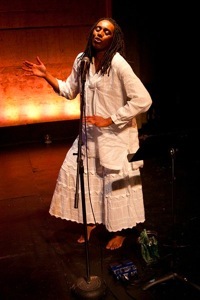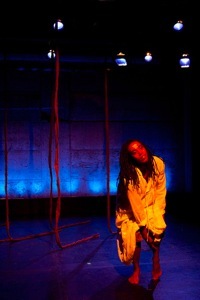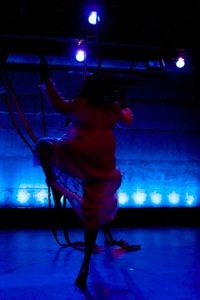INTERVIEW: Women Center Stage



I find that the human voice is a dynamic and infinitely expressive instrument. So for now, aside from my loop machines, the voice is the only instrument I play. I regularly listen to Bobby McFerrin, Meredith Monk, Tuvan and Inuit throat singing, kirtan, Ella Fitzgerald, Bjork’s album Medulla, John Coltrane chanting “A love supreme,” beatboxing, Sweet Honey in the Rock, Sheila Chandra, the list goes on. Any song that explores tonal layering, repetition, planned improvisation and percussive breath. Ache What Make draws from the harmonic intricacy of bebop and the grounded rhythms of Haitian Vodou.
2. Ache What Make is a work in progress. Can you talk a bit about the process of simultaneously performing and creating a piece?

3. Poet, playwright, performer—We find all three aspects of your creative identity (and then some) in this piece. How do you feel your varied interests fuse together and inform each other both in Ache What Make and in your work in general?
Simultaneity comes naturally to me. I am at once black, a woman and queer. I am at once Haitian, American and a traveller. Ache What Make is at once poetry, theatre and music. One day there will be a succinct word for that aesthetic combination. For now, let’s call it “live.”

As a teaching artist, I want to expose the scaffolding of an effective creative work. I want to empower my students to make bold, clear choices, to be honest, to fail and to risk being loved. I joke that I’m teaching emerging artists how to become obsessed—with a word, with a note, with a gesture, with a candidate, with a moment in history, with a question about the future. In my classroom, we practice presenting our obsessions in irresistible ways. We practice the performance techniques that will command and hold an audience’s attention. It’s more about pleasure than preaching.
5. What do you hope to accomplish with Ache What Make? What do you hope the audience takes away from this performance?
After the January 12, 2010 earthquake that devastated Haiti, I became obsessed with details. The media bombarded us with blurry images of dusty, nameless faces or distant, bird’s eye shots of shattered shacks and limp bodies in mass graves. But for me, as someone in the Diaspora, the Haitians on the screen were individuals with middle names, favorite colors, recurring jokes, hopes and dreams. Ache What Make offers a new way of seeing. It’s about zooming in and affirming life. I hope the audience takes in my Haitian hope.

